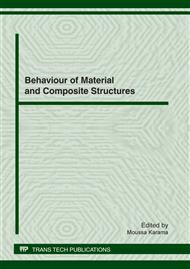[1]
N. Kikuchi and J.T. Oden, Contact problems in elasticity: A study of variational inequalities and finite elements, SIAM Philadelphia (1988).
DOI: 10.1137/1.9781611970845
Google Scholar
[2]
Z.H. Zhong, Finite element procedures in contact-impact problems, Oxford University Press (1993).
Google Scholar
[3]
P. Wriggers, Computational contact mechanics, Wiley New York (2002).
Google Scholar
[4]
T.A. Laursen, Computational contact and impact mechanics: fundamentals of modeling interfacial phenomena in nonlinear finite element analysis, Springer Berlin (2002).
Google Scholar
[5]
G. De Saxce and Z.Q. Feng: Math. Comput. Model., 28 (1998), p.225.
Google Scholar
[6]
T.A. Laursen and B.N. Maker: Inter. J. for Num. Meth. in Eng., 38 (1995), p.3571.
Google Scholar
[7]
T.A. Laursen and J.C. Simo: Inter. J. for Num. Meth. in Eng., 36 (1993), p.3451.
Google Scholar
[8]
T.A. Laursen and J.C. Simo: Computer Meth. in App. Mech. and Eng., 108 (1993), p.133.
Google Scholar
[9]
P. Wriggers: Comp. Meth. in Eng., 2, 4 (1995), p.1.
Google Scholar
[10]
A. Curnier: Inter. J. for Solids Structures, 20 (1984), p.637.
Google Scholar
[11]
D. Tabor: J. of Lubrication Tech., 103 (1981), p.169.
Google Scholar
[12]
A.A. Bandeira, P. Wriggers and P.M. Pimenta: 7th US Nat. Cong. on Comp. Mech., Albuquerque, New Mexico, USA (2003).
Google Scholar
[13]
A.A. Bandeira, P. Wriggers and P.M. Pimenta: European Conf. on Comp. Mech.: ECCM, Krakow, Poland (2001).
Google Scholar
[14]
J.C. Simo and T.A. Laursen: Computers & Struct., 42 (1992), p.97.
Google Scholar
[15]
M. Jean and G. Touzot, Journal of theoretical and applied mechanics, Special issue, supplement n°1 vol 7, (1988).
Google Scholar
[16]
E. Boudaia, L. Bousshine, A. Chaaba and G. De Saxsé: Inter. J. of App. Mech., Vol. 1, No. 4 (2009), p.1.
Google Scholar
[17]
G. De Saxce, and Z.Q. Feng: Mech. Struct. Mach., 19, 3 (1991), p.301.
Google Scholar
[18]
E. Boudaia, L. Bousshine, A. Chaaba, H.F. Fihri and G. De Saxsé: Mécanique & Industries, 10 (2009), p.487.
DOI: 10.1051/meca/2010008
Google Scholar
[19]
G. Dhatt and G. Touzot, Une présentation de la méthode des éléments finis, Maloine S.A. (1984).
Google Scholar
[20]
R.A. Murtagh and M.A. Saunders, Minos 5. 1 user's guide, Stanford University (1987).
Google Scholar


